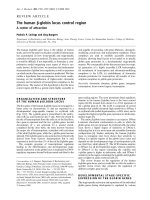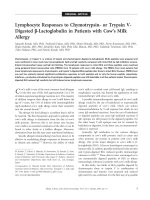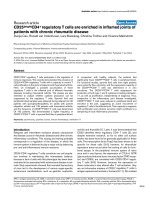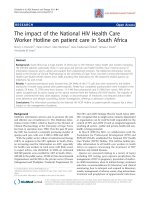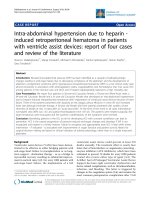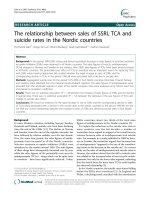Báo cáo y học: "The Nordic Maintenance Care Program - Time intervals between treatments of patients with low back pain: how close and who decides" pps
Bạn đang xem bản rút gọn của tài liệu. Xem và tải ngay bản đầy đủ của tài liệu tại đây (199.68 KB, 7 trang )
RESEARC H Open Access
The Nordic Maintenance Care Program - Time
intervals between treatments of patients with low
back pain: how close and who decides?
Kjerstin F Sandnes
1
, Charlotte Bjørnstad
1
, Charlotte Leboeuf-Yde
1,2
, Lise Hestbaek
1,2*
Abstract
Background: The management of chiropractic patients with acute and chronic/persistent conditions probably
differs. However, little is known on this subject. There is, for example, a dearth of information on maintenance care
(MC). Thus it is not known if patients on MC are coerced to partake in a program of frequent treatments over a
long period of time, or if they are actively involved in designing their own individualized treatment program.
Objectives: It was the purpose of this study to investigate how chiropractic patients with low back pain were
scheduled for treatment, with speci al emphasis on MC. The specific research questions were: 1. How many patients
are on maintenance care? 2) Are there specific patterns of intervals between treatments for patients and, if so, do
they differ between MC patients and non-MC patients? 3. Who decides on the next treatme nt, the patient, the
chiropractor or both, and are there any differences between MC patients and non-MC patients?
Methods: Chiropractic students, who during their summer holidays were observers in chiropractic clinics in
Norway and Denmark, recorded whether patients were classified by the treating chiropractor as a MC-patient or
not, dates for last and subsequent visits, and made a judgement on whether the patient or the chiropractor
decided on the next appointment.
Results: Observers in the study were 16 out of 30 available students. They collected data on 868 patients from 15
Danish and 13 Norwegian chiropractors. Twenty-two percent and 26%, respectively, were classified as MC pa tients.
Non-MC patients were most frequently seen within 1 week. For MC patients, the previous visit was most often
2-4 weeks prior to the actual visit, and the next appointment between 1 and 3 months. This indicates a gradual
increase in intervals. The decision of the next visit was mainly made by the chiropractor, also for MC patients.
However, the study samples of chiropractors appear not to be representative of the general Danish and Norwegian
chiropractic profession and the patients may also have been non-representative.
Conclusion: There were two distinctly different patterns for the time period between visits for MC patients and non-
MC patients. For non-MC patients, the most frequent interval between visits was one week and for MC patients, the
period was typically between two weeks and three months. It was primarily the chiropractor who made the next visit-
decision. However, these results can perhaps not be extrapolated to other groups of patients and chiropractors.
Background
A considerable proportion of patients seeking chiroprac-
tic care for low back pain suffer from relatively long-
lasting problems [1,2]. Some of these are treated only in
their acute phase, whereas others receive more pro-
longed care. This could be to prevent new episodes of
pain that are likely to occur, because of the recurring
nature of low back pain. Among chiropractors, second-
ary and tertiary prevention is called mainte nance care
(MC). Although MC ap pears to be relatively commonly
used among chiropractors, the prevalence with which
maintenance care is used has not been established, not
much is known about it [3], and its efficacy has been
tested only in a pilot study [4].
* Correspondence:
1
Institute of Clinical Biomechanics, University of Southern Denmark, Odense,
Denmark
Sandnes et al. Chiropractic & Osteopathy 2010, 18:5
/>© 2010 Sandnes et al; licensee BioMed Central Ltd. This is an Open Access article distributed under the terms of the Creative
Commons Attribution License ( which permits unrestricted use, distribution, and
reproductio n in any medium, provide d th e original work is properly cited.
Attempts have been made to obtain information on
chiropractors’ use of MC for patients with low back
pain. It has, for example, been established that there
seems to be relative consensus on its indications and
non-indications but it is not known how frequently such
patients are seen. In a study by Jamison, Australian chir-
opractors w ere asked with which time interval they saw
such patients. The responseswentfromonceamonth
to once every three to four months [5]. However, the
response rate in this study was only 22% and the results
were based on subjective reports. To our knowledge, no
other serious attempt has been made to establish the
visit patterns of MC patients.
To study this closer, it would be relevant to establish
if treatment scheduling of MC patients is indeed dis-
tinctly different from that of other patients. This should
be done o bjectively, and could be done either through a
study of patient files or through direct observations. We
opted for the latter, as it would also make it possible to
observewhetherthedecision of continued treatment
rested with the chiropractor or with the patient, or
whether it was a joint decision.
Obviously, in the acute stage, decisions on the number
and frequency of treatments would come mainly from
the clinician. In the case of MC, however, one would
expect more of a joint decision, or perhaps even that
the patient requested continued care. In such a case, the
use of MC can be looked upon as an active treatment,
in which the patient takes responsibility and shows
initiative to prevent new episod es of low back pain.
However, if a long-term treatment program is imposed
on patients, MC may become more of a passive ritual,
removing the responsibility for keeping well from the
patient to the treatment program. Such a strategy of
passive coping may be detrimental for the prognosis [6].
For these reasons it is relevant to investigate if MC
patients are more involved in the decision on the course
of treatment than non-MC patients.
Therefore, it was the purpose of this study to investi-
gate how chiropractic patients with low back pain were
scheduled for trea tmen t, with special emphasis on MC.
The specific research questions were:
1. What is the proportion of patients on MC care in
general chiropractic practice?
2. Are there specific patterns of intervals between
treatments for patients and, if so, how do they differ
between MC patients and non-MC patients?
3. Who decides on the next treatment, the patient, the
chiropractor or both, and are there any differences
between MC patients and non-MC patients?
Methods
This was an observational study, in which data about
the clinical e ncounter were collected on a pre-printed
form by student observers. In addition, information
about the chiropractors was collected in a self-report
questionnaire.
The observation form and questionnaire were
designed in April 2007. The questionnaire was written
in Danish. To ensure user friendliness and enhance the
likelihood of valid data, the forms were tested in a pilot
study by the project leaders (CB and KFS) in two Danish
chiropractic clinics. This resulted in some improvements
of the wording of questions and layout.
Third year chiropr actic students at the University of
Southern Denmark collected the data during their obli-
gatory one week c linical chiropractic practice period,
which took place during their summer holiday of 2007
(June-August). Students would often return to their
home during holidays, and they were allowed to observe
clinics situated in Denmark, Norway or Sweden. There
are no criteria set up by the university to approve clinics
for observation. The clinicians can contact the university
and volunteer to receive students or the students can
contact a chiropractor of their choice (often in their
hometown). The chiropractors receive a minor payment
from the university for receiving the students. The Dan-
ish, Norwegian and Swedish languages are very similar,
and no tra nslat ion of the question naire would be neces-
sary for participants outside of Denmark.
Data collection was voluntary and participation was
encouraged at a meeting at which the project leaders
informed their fellow students of the purpose of the
study and the role of the students. The involved stu-
den ts attended a meeting where detai led verbal instruc-
tion was provided on how to proceed and how to fill
out the o bservation forms. To standardize the discrimi-
nation between the three categories of decision-making,
this was followed by role plays illustrating four imagin-
ary chiropractic cases where an observation form was
completed for each case. A translated observation form
can be seen in Appendix 1.
Students would provide information on all patients
seen on the days of observation. For each patient, infor-
mation was collected about the previous visit and the
next. There were five time intervals to choose from: 1)
No new visit, 2) Next visit within one week, 3) Next
visit between 2 and 4 weeks, 4) Next visit between 1-3
months, and 5) Next visit in 3 months or later. If the
patient was a new patient to the clinic, this was noted.
It was expected that patients would return at different
time intervals depending on the duration since the last
visit and that the time between visits would gradually
increase.
The chiropractor was asked f or each patient, whether
(s)he could be considered to be a MC patient or not.
When a new appointment was de cided, the student
made a judgement on whether this decision was made
Sandnes et al. Chiropractic & Osteopathy 2010, 18:5
/>Page 2 of 7
1) mainly by the chiropractor, 2) mainly by the patient,
or 3) whether it was more of a joint decision.
All data were collected anonymously and neither the
chiropractor nor the patients could be identified.
According to Danish law, there is no need for approval
from an ethics committee for studies that do not
include examination of individuals or human material.
The chiropractors were alsoaskedtoprovidesome
demographic information (country of practice, gender,
age, years of clinica l experience, country in which they
received their chiropractic education, size of town in
which the clinic was located, and whether they were
clinic owners or not). This information was used to com-
pare the study sample with the tar get sample of chiro-
practors in the respective c ountries using information
obtained from the national chiropractic associations. Par-
ticularly, educational background was considered to be
important, as it was found in a previous study to predict
attitudes to the use of MC (Signe F Hansen, Anne Line S
Laursen, Tue S Jensen, Charlotte Leboeuf-Yde, Lise Hest-
bæk: The Nordic maintenance care program: what are
the indications for maintenance care in patients with low
back pain? A survey of the members of the Danish Chiro-
practors’ Association, submitted).
To encourage p articipation of the chiropractors, an
explanatory letter was sent out to the relevant clinics,
with information about the study and an appeal for the
chiropractors’ co-operation.
When data collection was completed, the students
returned the forms in a pre-sta mped and addressed
envelope to the main supervisor of the project. To moti-
vate the students to send the data back, participants
would be given a bottle of wine.
The data were analyzed manually from a spread-sheet.
Demographic data were c ompared to information
obtained from the chiropractic associations. Descriptive
data were produced for each variable and information
was compared for MC and non-MC patients. The differ-
ences between distributions were tested by means of
Fisher’s exact test.
All analyses were made separately for each country but
combined if there were no obvious differences between
the t wo. In order to study the appointment pattern,
patients’ past appointment was cross-tabulat ed against
the next appointment, separately for MC patients and
non-MC patients. To illustrate a possible difference in
the decision-making between MC-patients and o thers,
proportions were reported with 95% confidence interval.
Because our study sample turned out to be unrepre-
sentative of its underlying study population (see result
section) and the study sample of chiropractors was too
small, no attempts were made to control for extraneous
factors, such as school of graduation or age.
Results
Number of study participants
In all, 16 out of 30 student s participated in our study.
They collected data from 28 clinicians, 15 from Den-
mark, 13 from Norway (none from Sweden), but data
from two Norwegian clinicians had to be omitted due to
lack of information. In total, 868 patients were observed.
Of these, 61 had to be excluded because of missing
information. Fifty-six were new patients. According to
the c linicians, 209 (26%) of the remaining patients were
MC patients and 542 non-MC patients.
The range of clinicians per student was 1-4 and the
range of patients per student was 15-119. The median
number of patients observed by each student was 44 in
Denmark and 50 in Norway. The range of patients
observed for each clinician was 2-119 with a median of
30 in Denmark and 20 in Norway.
Number of maintenance care patients
The range of MC patients per chiropractor in Denmark
was 0%-50% and the mean and median values were 22%.
The range was 0% - 100% among the Norwegian chiro-
practors, with a mean value of 26% and a median of
10%. The Norwegian group included two chiropractors
with 0% MC patients and two with 93% and 100%,
respectively. No such extreme values w ere seen for the
Danish chiropractors.
Description of the chiropractors and their
representativeness
A comparison between the participa nts in th e study and
the underlying populations is shown in Table 1, with
information provided for each country and for the two
countries combined. Major differences are mentioned
below.
There was an overrepresentation of female partici-
pants in Denmark compared to the gender distribution
within the Danish profession but the opposite for the
Norwegian participants.
The age of the participating Danish chiropractors dif-
fered somewhat from the general population of chir o-
practors. In Norway, the vast majority (91%) of the
respondents were 30 to 39 years, whic h was almost
twice as many as expected.
Half of the Danish participants were educated at the
University of Southern Denmark, but only one-third of
the Danish chiropractors belonged to this category.
Similar differences were noted for the Norwegian
chiropractors.
In relation to years of clinical experience, there were
almost twice as many as expected in the Danish study
group with 0-1 year of clinical experience as compared
to the whole profession and the group with a clinical
Sandnes et al. Chiropractic & Osteopathy 2010, 18:5
/>Page 3 of 7
experience of 11-19 years was underrepresented (7% vs.
25%). This comparison could not be done for the Nor-
wegian chiropractors.
The majority of the Danish participants practised in
towns of more than 100.000 inhabitants whereas the
majority of the Norwegian participants were found in
towns of 20.000-100.000 inhabitants. No comparison
could be made with the study populations.
The percentages of clinic owners a nd employees cor-
responded well with the underlying Danish population.
This information was missing in relation to Norway
(Table 1).
In summary, the two study samples deviated consider-
ably from the underlying study population on several
variables and, notably, on the most important variable,
namely country of graduation. The study sample of
chiropractors can therefore not be considered to be
representative of its target group.
Are there specific patterns of intervals between
treatments for patients and, if so, do they differ
between MC patients and non-MC patients?
As can be seen in Table 2, for non-MC patients the lar-
gest group consisted of patients who had their last visit
within one week, and of these, 63% would be booked
for a new visit again within one week. In fact, regardless
of when the last visit took place, the most common
choice was to re-schedule again within 1 week. The sec-
ond most common choice was to give no new appoint-
ment, presumably because some patients were “cured”
and very few <1% would be given a new appointment in
3 months time or more.
Table 1 Demographic background of the chiropractors in the survey compared to the Danish Chiropractor’s
Association (DCA) and the Norwegian Chiropractor’s Association (NCA)
Danish
participants
n=15
DCA
n = 455
p Norwegian
participants
n=11
NCA
n = 397
p Total in
survey
Total DCA
and NCA
p
Sex
- Female 67% 51% 0,297 9% 30% 0,187 42% 41% 1,000
- Male 33% 49% 91% 70% 58% 59%
Age
- 20-29 27% 6% 0,037 0% 16% 0,025 15% 11% 0,261
- 30-39 27% 31% 91% 48% 54% 39%
- 40-49 20% 38% 0% 18% 12% 29%
- 50-49 27% 18% 0% 15% 15% 16%
- 60 or more 0% 7% 9% 3% 4% 5%
- missing - - - <1% - <1%
Country of graduation
- DK 53% 33% 0,181 27% 11% 0,479 42% 23% 0,218
- UK 7% 22% 36% 37% 19% 29%
- USA/Canada 40% 45% 36% 41% 39% 43%
- Other 0% <1% 0% 4% 0% 2%
- missing - <1% - 7% - 3%
Clinical experience (years)
0-1 13% 7% 0,306 9% - 12% -
2-5 27% 18% 7% - 27% -
6-10 13% 10% 27% - 19% -
11-19 7% 25% 27% - 15% -
more than 20 40% 38% 9% - 27% -
missing - 2% - - - -
Size of town/village
0-20.000 7% - 0% - 4% -
20-100.000 33% - 73% - 50% -
> 100.000 60% - 27% - 46% -
Clinic owner/Employee
- Clinic owner 67% 62% 0,793 82% - 73% -
- Employee 3% 38% 18% - 27% -
Reported in percentages and p-values for the difference between distributions, tested by means of Fisher’s exact test.
Sandnes et al. Chiropractic & Osteopathy 2010, 18:5
/>Page 4 of 7
Table 3 shows how, for the MC patients, the last visit
most commonly occurred within the past 2-4 weeks, or
within the past 1-3 months. There were two equally
large groups who were last seen within 1 week or within
3 months or later.
Contrary to the non-MC patients, the re-scheduling of
MC-patients depended on when the last visit occurred.
Those last seen within 1 week would again be booked
within 1 week (51%), those last seen within 2-4 weeks
would be seen again within the same time interval (32%)
or within 1-3 months (40%). Those last seen within 1-3
months would again be scheduled in 1-3 months (58%)
and those who came at least 3 months ago would do so
again (45%). The most commonly selected interval for
next visit was between 1 and 3 months.
Who decides on the next treatment, the patient, the
chiropractor or both, and are there any differences
between MC patients and non-MC patients?
For both MC patients and non-MC patients the chiro-
practors in our study would be the primary initiators in
relati on to the subsequent treatment. The estimates were
higher for the Danish chiropractors than for the Norwe-
gian chiropractors. For the Norwegian participants, it
was almost as common that both chiropractor and
patient were involved with this decision. This was far less
common among the Danish chiropractors. Among the
Danish chiropractors, a higher degree of patient influence
was noted among the MC-patients than among the non-
MC patients, with 34% and 20%, respectively, involved in
the decision about the next visit. A similar pattern was
not detected in Norway (Table 4).
Discussion
We found that 22% of the patients in Denmark and 26%
of the patients in Norway were on maintenance care,
illustrating the need to take th is aspect of care seriously.
In a survey among all practising chiropractors in Den-
markwitharesponserateof72%,theproportionof
MC patients was 22% (Signe F Hansen, Anne Line S
Laursen, Tue S Jensen, Charlotte Leboeuf-Yde, Lise
Hestbæk: The Nordic maintenance care program: what
are the indications for maintenance care in patients with
low back pain? A survey of the members of the Danish
Table 2 The time period for the next treatment by the time period for the last treatment for non-maintenance care
patients in a survey of chiropractors in Denmark and Norway
DK+N No new visit
(n = 108)
Next visit within 1
week (n = 297)
Next visit between 2-4
weeks (n = 84)
Next visit between
1-3 months
(n = 51)
Next visit in over 3
months or later (n = 2)
Total
Last visit within
1 week (n = 342)
17% 63% 15% 4% 0% 100%
Last visit within
2-4 weeks (n = 107)
21% 31% 23% 23% 1% 100%
Last visit within
1-3 moths
(n = 44)
27% 41% 11% 18% 2% 100%
Last visit within
3 months or later
(n = 49)
29% 61% 4% 6% 0% 100%
The bold print show percentage of time-interval s which were most commonly used.
Table 3 The time period for the next treatment by the time period for the last treatment of maintenance care
patients in a survey of chiropractors in Denmark and Norway
DK+N No new visit
(n = 20)
Next visit within
1 week (n = 42)
Next visit between
2-4 weeks (n = 41)
Next visit between 1-3
months (n = 80)
Next visit in over 3
months or later (n = 26)
Total
Last visit within
1 week (n = 37)
3% 51% 27% 16% 3% 100%
Last visit within
2-4 weeks (n = 72)
10% 15% 32% 40% 3% 100%
Last visit within
1-3 moths
(n = 62)
13% 13% 6% 58% 10% 100%
Last visit within
3 months or later
(n = 38)
11% 11% 11% 24% 45% 100%
The bold print show percentage of time-interval s which were most commonly used.
Sandnes et al. Chiropractic & Osteopathy 2010, 18:5
/>Page 5 of 7
Chiropractors’ Association, submitted). This indicates
that although our sample of chiropractors is not repre-
sentative, at least the Danish part of the sample is repre-
sentative in this aspect. We are not aware of similar
investigations in Norway.
This appears to be the first study to have looked at
the time frame betw een visits for patients with low back
pain attending chiropractic clinics, and also the first
study to look at the point of initiative for the subse-
quent visit. We found that there were two distinct pat-
terns in how new visits are scheduled. For non-MC
patients a new appointment would often be booked
within one week whereas there were more possibilities
for MC patients. These possibilities seemed to depend
on when the previous visit occurred.
From our study, it is impossible to know whether this
was a dynamic patter n, i.e. that these patients wer e
booked with different intervals depending on their clini-
cal development, or a static o ne, i.e. that patients were
booked repeatedly with identical treatment intervals.
ThemostcommonlyusedintervalforMCpatients
was 1-3 months. Longer intervals were much less com-
mon, in fact almost as uncommon as no new visit.
We were surprised to note that the patients of the
Danish chiropractors in this study had so little say in
the course of their treatment, although the MC patients
did have a slightly higher degree of influence than the
acute patients, as we expected. The Norwegian partici-
pants were also found to favour the paternalistic
approach, but it was almost equally as common in this
group that both the chiropractor and the patient took
part in the decision of the next appointment.
However, these results may not necessarily be extrapo-
lated to other groups of chiropractors. The reason for
this is that the chiropractors of our study appeared not
to be representative of the chiropractors in Denmark
and Norway.
This lack of representativeness is p erhaps not surpris-
ing. The chiropractors who participated in the study
accepted that students observed them during their work.
Graduates from the Danish university course would
probably be more inclined to accept students from that
same place, which would explain the educational skew-
ness in our study sample. Educational background has
previously been shown to have an effect on Danish chir-
opractors’ attitude to MC (Signe F Hansen, Anne Line S
Laursen, Tue S Jensen, Charlotte Leboeuf-Yde, Lise
Hestbæk: The Nordic maintenance care program: what
are the indications for maintenance care in patients with
low back pain? A survey of the members of the Danish
Chiropractors’ Association, submitted). This is likely to
have biased our results in unknown direction.
Not all of the eligible students accepted to help with
the study. It is, of course, possible that also this c ould
have resulted in a bias, if participating students were
more interested in MC and/or recorded the data inaccu-
rately. However, this is not very likely, because the data
recording left little room for subjectivity.
A likely source of error, however, is the time of year,
when data were collected. This took place during the sum-
mer holidays, a period with less activity in many clinics,
and probably with an over representation of patients in
acute pain. The proportion of no new visits may also have
been inflated, if they emanated from tourists, who con-
sulted a chiropractor for emergency assistance. Therefore,
the proportion of MC patients in the involved practices
may be larger during the rest of the year. The day of the
week or the time of the day, when data were collected,
may also have affected the ratio of non-MC patients and
MC patients. For example, in Denmark, many chiroprac-
tors rarely book MC patients on a Monday, when emer-
gency cases are expected, and some chiropractors even set
aside certain times on certain days for that type of patients.
Despite the weaknesses of this study, it also has some
strengths. Data were based on observations rather than
subjective estimates. The forms and question naires were
standardized to make it possible to compare and analyse
data from the different clinics and students had been
thoroughly instructed in how to use the forms and how
to return them, thus minimizing the risk of data collec-
tion errors. In a future study, patient files will be exam-
ined retrospectively to establish the time pattern of visits.
Conclusion
In this particular group of chiropractors, MC was used
for about one quarter of the patients, ranging from 0%
Table 4 Table describing who takes the initiative for the
next appointment, the chiropractor, the patient or both
in a survey of maintenance and non-maintenance care
patients treated by Danish and Norwegian chiropractors
DENMARK
Initiative
taken by
Maintenance care
patient (n = 103)
Non-maintenance care
patients (n = 318)
Chiropractor 61% (51-71%) 74% (69-79%)
Patient 7% (3-14%) 4% (2-7%)
Both 27% (19-37%) 16% (12-21%)
Missing 5% (2-11%) 6% (4-9%)
100% 100%
NORWAY
Initiative
taken by
Maintenance care
patient (n = 106)
Non-maintenance care
patients (n = 224)
Chiropractor 47% (37-57%) 47% (40-54%)
Patient 10% (5-18%) 9% (6-13%)
Both 43% (2-11%) 40% (34-47%)
Missing 0% 4% (2-7%)
100% 100%
Percentage (95% confidence interval)
Sandnes et al. Chiropractic & Osteopathy 2010, 18:5
/>Page 6 of 7
to 100% between clinics. The intervals with which the
chiropractors saw their MC patients were distinctly dif-
ferent from that of their non-MC patients. An interval
of 1-3 months for t he next appointments was most fre-
quently used for MC patients but this depended on the
duration since the last treatment. In most cases, the
observing student c onsidered that the chiropractor and
not the patient took the initiative in arranging the next
appo intm ent, regardless of whether it was a MC pat ient
or a non-MC patient. However, it is not known, if these
results can be extrapolated to other groups of chiroprac-
tors and other types of patients.
Information about authors
This study was a part requirement for the MSc degree
in health science (biomechanics), at the University of
Southern Denmark, Odense, Denmark for CB and KFS.
Author details
1
Institute of Clinical Biomechanics, University of Southern Denmark, Odense,
Denmark.
2
Nordic Institute for Chiropractic and Clinical Biomechani cs,
University of Southern Denmark, Odense, Denmark.
Authors’ contributions
CLY and LH were responsible for conception and design, CB and KFS carried
out the data collection, all authors contributed to data analysis and
interpretation, CLY and LH drafted the manuscript. All authors read and
approved the final manuscript.
Competing interests
The authors declare that they have no competing interests.
Received: 1 October 2009 Accepted: 8 March 2010
Published: 8 March 2010
References
1. Leboeuf-Yde C, Axen I, Jones JJ, Rosenbaum A, Lovgren PW, Halasz L, et al:
The Nordic back pain subpopulation program: the long-term outcome
pattern in patients with low back pain treated by chiropractors in
Sweden. J Manipulative Physiol Ther 2005, 28:472-478.
2. Malmqvist S, Leboeuf-Yde C, Ahola T, Andersson O, Ekstrom K,
Pekkarinen H, et al: The Nordic back pain subpopulation program:
predicting outcome among chiropractic patients in Finland. Chiropr
Osteopat 2008, 16:13.
3. Leboeuf-Yde C, Hestbaek L: Maintenance care in chiropractic - what do
we know? Chiropr Osteopat 2008, 16 :3.
4. Descarreaux M, Blouin JS, Drolet M, Papadimitriou S, Teasdale N: Efficacy of
preventive spinal manipulation for chronic low-back pain and related
disabilities: a preliminary study. J Manipulative Physiol Ther 2004,
27:509-514.
5. Jamison JR: Preventative chiropractic: What justification? Chiropractic
Journal of Australia 1991, 21:10-12.
6. Woby SR, Roach NK, Urmston M, Watson PJ: The relation between
cognitive factors and levels of pain and disability in chronic low back
pain patients presenting for physiotherapy. Eur J Pain 2007, 11:869-877.
doi:10.1186/1746-1340-18-5
Cite this article as: Sandnes et al.: The Nordic Maintenance Care
Program - Time intervals between treatments of patients with low back
pain: how close and who decides?. Chiropractic & Osteopathy 2010 18:5.
Submit your next manuscript to BioMed Central
and take full advantage of:
• Convenient online submission
• Thorough peer review
• No space constraints or color figure charges
• Immediate publication on acceptance
• Inclusion in PubMed, CAS, Scopus and Google Scholar
• Research which is freely available for redistribution
Submit your manuscript at
www.biomedcentral.com/submit
Sandnes et al. Chiropractic & Osteopathy 2010, 18:5
/>Page 7 of 7
